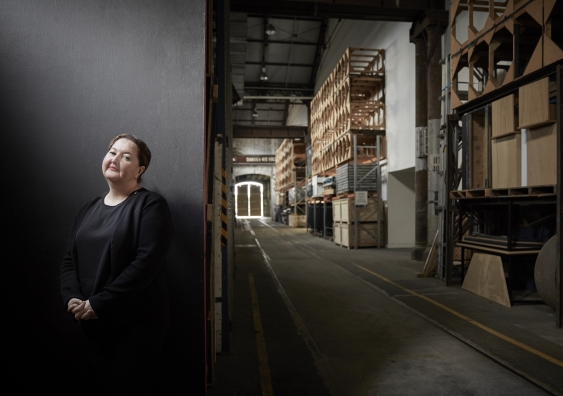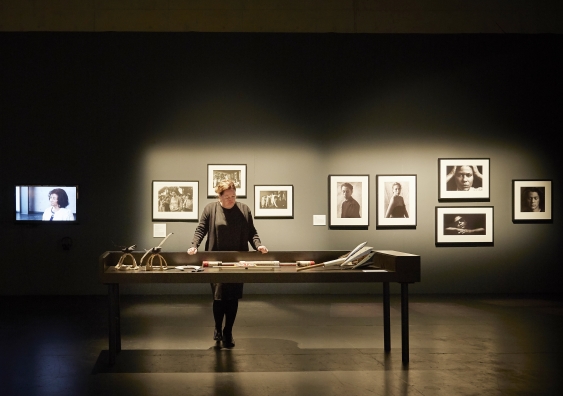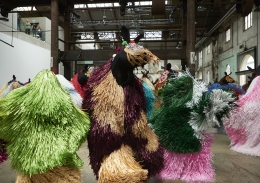Cultural warrior
Carriageworks Director Lisa Havilah has turned the historic artspace into one of Australia’s most exciting cultural institutions.
Carriageworks Director Lisa Havilah has turned the historic artspace into one of Australia’s most exciting cultural institutions.

If you’re not scared you’re not doing your job,” says Lisa Havilah as she stands in one of the cavernous, warehouse spaces at Carriageworks. She glances at her phone which pings constantly and raises her voice above the noise of yet another train barrelling past.
“To me being scared means making sure you’re working outside of not just your comfort zone, but your capacity, and continually taking risks.”
This daunting work ethic, combined with a love of the unknown, has helped Havilah transform the sprawling Carriageworks near Sydney’s Redfern Station – once considered the white elephant of the city’s cultural sector – into a thriving contemporary multi-arts centre commissioning and presenting work across music, dance, performance and visual arts.
The building, with its magnificent history and expansive spaces, has been Havilah’s workplace for the past five years. Under her direction, an impressive line-up of new and established artists have performed and exhibited in its theatres and galleries.
Björk premiered her virtual reality project Björk Digital here, allowing Sydneysiders to virtually tour the singer’s mouth, while French choreographer Olivier Dubois’ dramatic Australian premiere of Tragédie, involving 18 naked dancers writhing in synchronicity, brought an entirely different energy to the space.
But the big international acts are only one part of Carriageworks’ artistic program. Havilah is also committed to making sure the artists selected by the cultural institution reflect the history and the future of the local community.
“This building has an incredible history of inclusion and access,” she says, stepping across one of the old railway lines that weave through the building.
“In the late 1800s, 6,000 railway workers were employed here every day, many of whom were migrants, and it was one of the first workplaces in NSW to employ Indigenous Australians on an equal basis. Our artistic program directly reflects that social and cultural diversity, with a focus on engaging new communities.”

Lisa Havilah in Naya Wa Yugali – We Dance, Naisda 40th anniversary, Carriageworks, 2016
She says more than 70% of the artists who took part in the 2016 Carriageworks’ artistic program were from culturally diverse backgrounds. “It’s one of the highest percentages of any cultural institution in Australia,” she says.
A graduate of UNSW’s Master of Arts Administration, Havilah has long been committed to social equity and inclusion. As an emerging visual artist she co-founded Wollongong’s Project Contemporary Artspace out of frustration that there was nowhere for local talent to exhibit. She then worked in Sydney’s culturally diverse western suburbs for more than a decade as Assistant Director of Casula Powerhouse Arts Centre and then Director of Campbelltown Arts Centre, where she pioneered new approaches to how cultural institutions engage with local communities.
“There’s a lot changing across the arts and cultural sector – the historical silos and ways of working have broken down. The public and private are merging and cultural institutions need to become more entrepreneurial. Artists are already beginning to work that way and institutions need to follow suit.
“Connecting artists with local communities to try and reflect the demographic and social issues of the area has always been my priority,” she says. “One of the most important things I learned working in western Sydney is that as a curator, you can’t just dip in and out of an artist’s practice – it has to be ongoing. You need to create a three-way collaboration between the institution, the community and the artist, and the longer you work together the more expansive the outcome.”
The word ‘collaboration’ pops up frequently in conversations with Havilah. She thinks it is critical for arts and cultural institutions to join forces in a sector overwhelmed by funding challenges and reduced government support.
“To me being scared means making sure you’re working outside of not just your comfort zone, but your capacity.”
It is a sentiment Professor Ross Harley, Dean of UNSW Art & Design, agrees with. The faculty is actively forging relationships with many of Sydney’s cultural organisations – including Carriageworks, the Art Gallery of NSW, Artspace, the Australian Design Centre and the Museum of Contemporary Art – to ensure Sydney continues to grow artistically and culturally.

; Nick Cave, HEARD• SYD, Carriageworks, 2016
He says Carriageworks sets a strong example of how arts and cultural institutions can support each other.
“Lisa is a force to be reckoned with. She has a genuinely collaborative approach and a deep commitment to many different aspects of contemporary culture,” says Harley. “She also has a canny sense of what the next big thing might be, without being trendy or elitist.”
Carriageworks’ six-year strategy projects that more than two million visitors will engage with its artistic program annually by 2021, making it one of Australia’s busiest cultural institutions. This sort of vision takes ambition.
“You can’t develop without seizing opportunities and being resilient when they go wrong,” Havilah says. “We, the board and the staff, want to make sure Carriageworks continues to grow. We can never assume we have got it all worked out.”
But there are moments among the complexity of running a large cultural institution that Havilah describes as “pure joy”. She says Nick Cave’s Heard, billed as a “stampede of dancers disguised as colourful raffia horses performing to the tribal beat of eight live drummers”, was one of her favourite performances in last year’s program.
“I never expected Heard, which is so beautiful and magical, to have such an emotional impact on the audience, just because of the sheer beauty of it.
“What I love about this job is watching people engage with contemporary art. I’m lucky to be able to stand in the audience, feel the atmosphere in the room and witness those moments.”